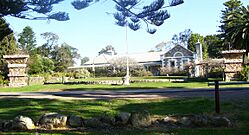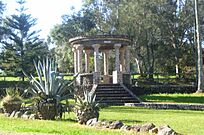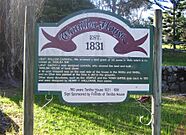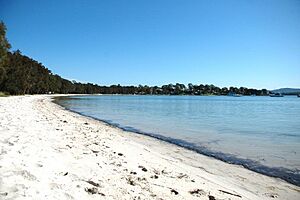Tanilba Bay, New South Wales facts for kids
Quick facts for kids Tanilba BayNew South Wales |
|||||||||||||||
|---|---|---|---|---|---|---|---|---|---|---|---|---|---|---|---|
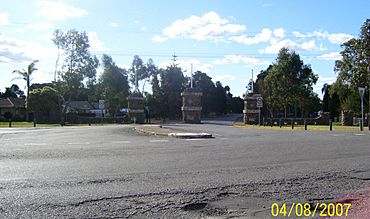
The distinctive entrance to Tanilba Bay from Lemon Tree Passage Road
|
|||||||||||||||
| Population | 3,237 (2021 census) | ||||||||||||||
| • Density | 249/km2 (640/sq mi) | ||||||||||||||
| Established | 1831 | ||||||||||||||
| Postcode(s) | 2319 | ||||||||||||||
| Elevation | 3 m (10 ft) | ||||||||||||||
| Area | 13 km2 (5.0 sq mi) | ||||||||||||||
| Time zone | AEST (UTC+10) | ||||||||||||||
| • Summer (DST) | AEDT (UTC+11) | ||||||||||||||
| Location |
|
||||||||||||||
| LGA(s) | Port Stephens Council | ||||||||||||||
| Region | Hunter | ||||||||||||||
| County | Gloucester | ||||||||||||||
| Parish | Sutton | ||||||||||||||
| State electorate(s) | Port Stephens | ||||||||||||||
| Federal Division(s) | Paterson | ||||||||||||||
|
|||||||||||||||
|
|||||||||||||||
Tanilba Bay is a lovely suburb in the Hunter Region of New South Wales, Australia. It's part of the Port Stephens Council area. This town sits on the Tilligerry Peninsula, right next to the bay that gave it its name. The word "Tanilba" is thought to mean "place of white flowers" in a local Indigenous language. This probably refers to the beautiful flannel flowers that used to grow there. In 2021, about 3,237 people lived in Tanilba Bay. The town also has a primary school called Tanilba Bay Public School.
Contents
Tanilba House: A Historic Home
The most important building in Tanilba Bay is Tanilba House. You can find it on Caswell Crescent. This house is one of Australia's oldest buildings and the oldest in the Port Stephens area. It's so special that it's listed on the New South Wales State Heritage Register.
Building Tanilba House
In 1831, a man named Lieut William Caswell, who was in the Royal Navy, received a large piece of land. He was given help from convicts to clear the land. They also built Tanilba House using local stone and a special mortar made from oyster shells. A small jail was even built on one side of the house.
Soon after the house was built, about 4 hectares (10 acres) of land nearby became a vineyard. An olive tree planted in that vineyard is still alive today! It's also a protected heritage item. Other old plants like a bunya pine, a wisteria-covered pergola, and two Port Jackson fig trees are also specially listed.
Early Challenges and Changes
William and Susan Caswell had 11 children. Sadly, two of their young sons passed away at the house. The family faced tough times, including a drought. They also lost most of their workers when the British government stopped sending convicts to Australia. Because of these challenges, the Caswells left the house in the 1840s. For many years, the house was empty and fell into disrepair.
Restoration and New Owners
In the late 1800s, Elizabeth Holmes began important restoration work on the house. She bought the property in 1897 and started fixing it up. Later, in 1905, W J Ebbeck bought Tanilba House to use as a holiday home for fishing trips. In 1913, Walter W Cliff became the owner.
In 1931, Henry Halloran owned Tanilba House. He was an important designer. He created many unique structures on the property. These include "The Temple," which is visible from the main road, a circular stone driveway, and a "wishing chair." He also designed the fancy stone gates at what were once the entrances to the town. The stone for these structures came from nearby Mallabula. The northern gates are called the "water gates" because they were meant to welcome visitors arriving by boat.
Recent History of Tanilba House
In the 1950s, Tanilba House became a guest house and a riding school. The Oberland family bought the property in the 1960s and saved it from being torn down. In 1980, the government put a special order on the house to protect it forever.
Helen Taylor lived in the house from the 1980s until she passed away in 2015. She used the house for art shows, plays, poetry readings, and concerts. She also opened it to the public as a museum. In 2017, the current owners, Glenn Short and Deirdre Hall, bought the property and started new restoration work.
Tanilba Bay's Main Beach
Tanilba Bay has a lovely main beach located on the southern side of Port Stephens. It stretches from east to west.
Exploring the Beach Area
The eastern part of the beach can be reached by a boardwalk. This boardwalk has steps that lead down to small inlets. These spots offer access to the beach and are shaded by native trees. These trees are known for being home to koalas!
The middle and western parts of the beach have picnic areas and parks. There are also boat ramps for those who enjoy being on the water. The very western end of the beach has a wide stretch of sand.
Tides and Water Sports
When the tide is very low, large sandy flats appear. Sometimes, during high tide, the water covers all the sand. The bay is protected from strong southerly winds. This makes it a great spot for water sports, like water skiing.



